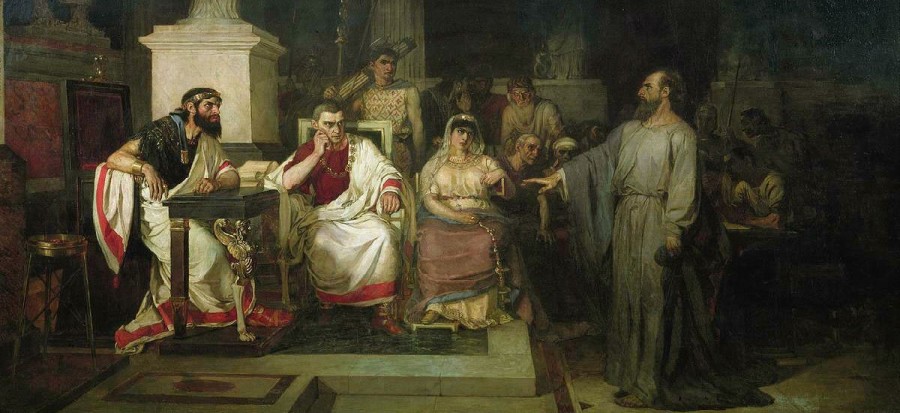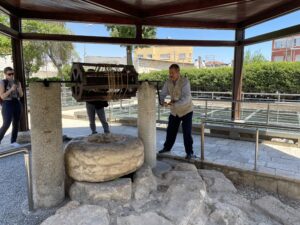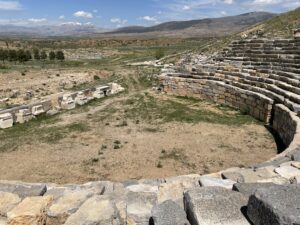The Apostle Paul’s Turkish Journeys Can Be Retraced Today — and It’s Worth the Trip

"The Apostle Paul explains the tenets of faith in the presence of King Agrippa, his sister Berenice, and the proconsul Festus" by Vasily Surikov, oil on canvas, 1875.
The world’s most famous Turk is not Mustafa Kemal Atatürk, founder of modern-day Turkey, but the Apostle Paul.
And Turkey — which was rebranded Türkiye last year — cherishes the ground on which he walked and has spiffed up the locales in which he walked. Google “footsteps of St. Paul tours” to see there’s no lack of ways to get there.
Following Paul’s Missionary Journey
A scant three months after earthquakes devastated parts of south-central Turkey, I was part of a group of journalists who traveled through some of Paul’s old stomping grounds as guests of the Turkish tourism board. We followed part of his 1,225-mile first missionary journey, which started in Cyprus, then wound about south-central Turkey before heading back to his home church in Antioch, near the Syrian border.
As we drove through the rugged Taurus range separating the coast and central plains, I began to see what a mammoth task it was to crisscross those mountains multiple times to evangelize the central Anatolian plateau. (Even Alexander the Great had a tough time getting through there).
“He did about 20 miles a day,” said Jason Borges, assistant director of the Asia Minor Research Center (AMRC) in Antalya, a seaport on Turkey’s southern coast. “There were inns you stayed at, but they were more like brothels, so they camped out or stayed with friends.”
“They” were Paul’s companions, such as Barnabas, who came along on the first journey. Traveling was dangerous and in Paul’s later journeys, he traveled with a larger group, as there were vigilantes and robbers. (In 2 Cor 11:26, Paul refers to bandits).
Paul’s Preaching the Gospel
Paul traveled some 10,000 miles during the roughly 25 years he preached the Gospel around the Roman Empire. Turkey was a key transit point. Mark Wilson (founder and director of the AMRC) points out in his book Biblical Turkey: A Guide to the Jewish and Christian Sites of Asia Minor, that half of the New Testament (the letters to the Galatians, Ephesians, Colossians, 1 and 2 Timothy, Revelation, Philemon and 1 and 2 Peter) were written to churches there. From within its borders, 1 and 2 Corinthians and John 1-3 were written to churches elsewhere.
Journeys Through Turkey
All of Paul’s missionary journeys went through Turkey. The seven churches of the book of Revelation were in western Turkey. The first seven ecumenical councils were in Turkey. When Jewish sedition in Rome began heating up in the 60s AD, early Christians like the Apostle John — remembering Jesus’ prophecies about the fall of Jerusalem — left for safer havens in Turkey.
Get The Stream’s daily news roundup, quick and served with a healthy splash of humor. Subscribe to The Brew

Known as “St. Paul’s well,” this crank-operated well still offers potable water.
There are several places where Paul preached that are worth visiting in the central plateau region also known as Galatia. Paul’s letter to the Galatians warns them against those who would water down the faith that Paul cultivated during his visits there.
Many Pauline tours start in Tarsus, Paul’s birthplace and a city on Turkey’s southeastern coast. Although there’s some 20 feet of silt overlying historic Tarsus, one can see “St. Paul’s well,” a site within a rose garden with a working well next to a Maltese plum tree. One can drink from that well using a common cup. Some 20 feet down — covered with a Plexiglas-like roof — are the ruins of a home where Paul’s family may have lived.
No Visible Christian Presence in Tarsus
There is no visible Christian presence in the city except for a 19th-century Romanesque structure — St. Paul’s Church — that operates as a museum. Surrounding it is a lovely garden of mulberry bushes. Borges told me there’s a Protestant house church in the vicinity, but it stays hidden in this overwhelmingly Muslim milieu.
From there, most tours head north through the Taurus mountains, arriving in Konya, an attractive, clean city known for its Islamic conservatism (most of the women were swathed in black scarves and skirts). Called Iconium in the first century, Paul’s preaching there nearly got him stoned to death (see Acts 14). Paul and Barnabas fled southwest 20 miles to Lystra where he got a better reception and met Timothy, who would join him on a later journey.
Many Unexcavated Sites
Today, Lystra is a large mound in the midst of potato and onion fields. For such an important site (at least in Christian eyes) to be unexcavated is not unusual; Turkey has thousands of such sites, most of which require a well-funded university with archeologists to mount a multi-year dig.
Please Support The Stream: Equipping Christians to Think Clearly About the Political, Economic, and Moral Issues of Our Day.
Noticing a lovely tree with purple blossoms on it just inside the gate of a farm, my group asked our guides to get the name of it from the farmer we saw in the driveway. Next thing we knew, we were seated at an outdoor table with Turkish delight and chocolates. Paul and Barnabas may have stopped at farms like this to get a bite to eat.
Konya Archaeological Museum
We also dropped by the Konya Archeological Museum, with objects dating from 7,000 years ago to the founding of Christianity. I was not aware of how many civilizations had passed through Turkey through the millennia, leaving remnants of temples, pillars, graves, statues and whatnot to the point where the locals are blasé whenever they dig up a piece of marble. Archeology in Turkey is subject to 2,000 years of looters, Christian destruction of pagan statues, weather deterioration and locals who wanted to use the marble to shore up their own homes.
“In every garden or farm there are Roman capitals serving as coffee tables,” our guide Damla Arslan told us.
Paul’s Major Evangelistic Speech
About a two-hour drive west of Konye is Pisidian Antioch, the site of one of Paul’s major evangelistic speeches (see Acts 13) in 46 AD. Sergius Paulus, a Roman proconsul who Paul encountered a few weeks earlier in Cyprus, had influential family connections there, so Paul and Barnabas had made a beeline for this place some 100 miles inland.

This ancient theater in Pisidian Antioch could have seated 5,000 people. It is near the modern-day town of Yalvaç, meaning “prophet,” referring to the Apostle Paul.
Roman Ruins and the Yalvaç Museum
Pisidian Antioch is now a vast set of Roman ruins less than a mile from the modern city of Yalvaç (meaning “prophet,” a reference to St. Paul). The Yalvaç museum was one of the better museums we visited, the translations were in very good English, it had very clean bathrooms and the only handicap ramp I saw during my journey. It also had a room devoted to St. Paul. Like the museum in Konya, we could touch the statues, capitals and friezes, huge vases and run our fingers along the mosaics, which we’d never be allowed to do in an American museum.
Up the hill was the ruined city, overlooking snow-covered mountains to the west. As shepherds wearing black ski jackets and jeans and carrying long sticks walked by, we approached a large arched west gate, originally built in honor of the Emperor Hadrian in 129 AD with a frieze depicting angels, Amazon shields, bull heads, sea creatures and weapons. The city was at a major crossroads on a Roman highway known as the Via Sebaste. Walking along the main thoroughfare, we saw what once were merchant shops, now with fig trees bursting out of their walls.
Ongoing Excavations
Excavations have been going on in Pisidian Antioch for about a century, so the main theater, forum and an impressive grid of streets with its own underground sewage system has long since been unearthed. The theater could seat 5,000 people. It’s a lovely spot, particularly in the spring where the fields were awash with red poppies, yellow daisies, purple thistles and tiny buttercups.

The path in Yazili Canyon in south-central Turkey is one of several ancient routes the Apostle Paul may have taken through the Taurus Mountains.
Even after Paul’s visit, the city retained its prominence and its bishop, Optimus, represented the city at the Council of Constantinople in 381. A basilica was built there on the site of what was thought to be a synagogue. Pisidian Antioch stayed a Christian city — with churches in every neighborhood — until 713 AD when an Arab raid leveled the place. By the 11th century, its inhabitants had moved downhill to Yalvaç, and the site remained an obscure ruin until British explorers came across it in the early 19th century.
Yazili Canyon
From there, one travels west through Isparta, Turkey’s lavender district, to visit the Yazili Canyon, a beautiful, forested spot next to the turquoise-colored waters of a river. There’s a small day park there and several hiking paths that are thought to be much the same route that Paul took through the Taurus mountains.
My favorite spot was Adada, a Roman colony built in the second century B.C. in a mountain pass between the canyon and Isparta. Ruins of villas were perched on the sides of a ravine not far from a toll house for travelers along the nearby Roman road. Arriving just before sunset, we picked our way down one path past twisted oak, juniper and olive trees and clumps of purple and cream flowers to an ancient stone cathedral.
“Many structures here are unique,” Ahmet Mörel, a professor at Süleyman University in Isparta, told us. Among the ruins of five churches found there, four of them had unique bleacher-style seats not seen elsewhere, he said.
We climbed back to the main road and saw a wild horse – pure white – gallop by. As if to enhance the magic of the area, we walked through fields dotted with well-preserved Greek temples built to various emperors. Tossed into the bushes like a huge salad were chunks of pillars and tops of gates and arches. We kept on walking through the grey-blue dusk through this stony landscape to see a small theater. Suddenly the sun broke through, turning the surrounding hills into gold.
A New Paul
From Adada to Galatia, none of this vast territory was evangelized when Paul first arrived. By the time he died two decades later, tiny churches had already taken hold. Within two centuries, it had become the cradle of Christianity.
But today, after 14 centuries of Islamic rule, Turkey’s Christian population is less than .5 percent and those who remain endure low-level persecution and attacks. Perhaps a new Paul will arise from among them to preach in the town squares and remind all of Turkey of the Christian heritage it once had.
A veteran journalist and writer, Julia Duin has written and worked for several major newspapers, including the Washington Post, the Wall Street Journal, and the Washington Times. She blogs at GetReligion. Her latest book is In the House of the Serpent Handler: A Story of Faith and Fleeting Fame in an Age of Social Media. Read more about her and her writing at Julia Duin.







